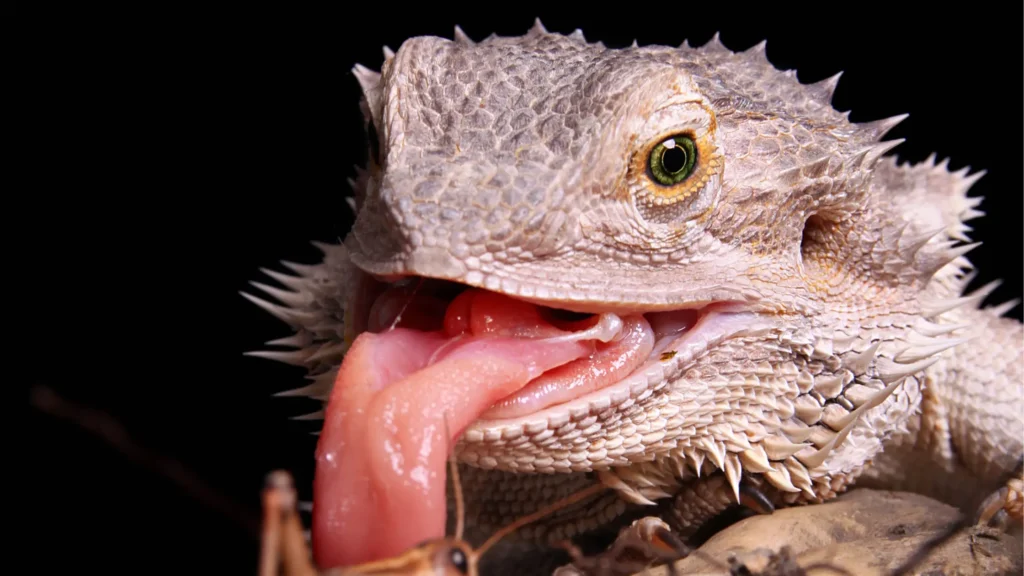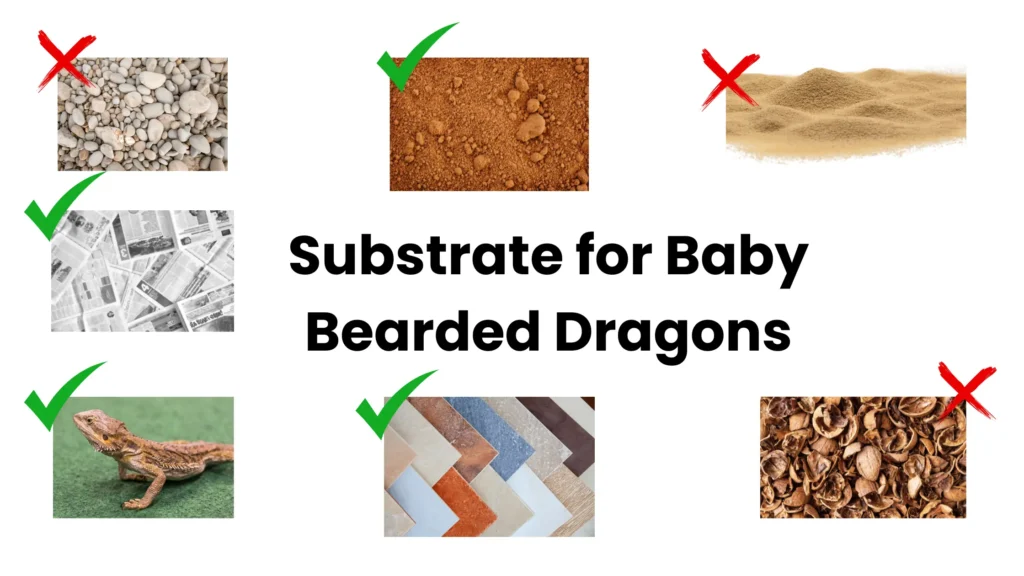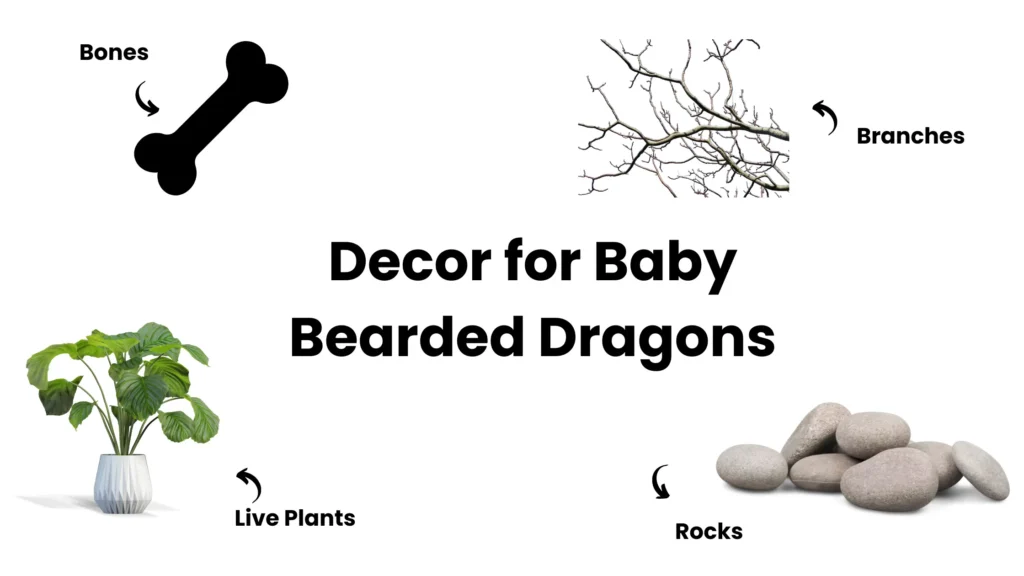Good job if you have bought baby bearded dragons. But, hey we gotta tell you this. It’s not easy to care for baby bearded dragons. They are really difficult to care for. This is because, at this age, they don’t have a developed immune system. Lots of bearded dragon babies also have atadenovirus which is a viral infection. This is mostly common in baby bearded dragons because usually when they are in a breeder’s shop, then more than one dragon is put in a single enclosure. If one has this virus, then since all the other dragons are also in the same enclosure, then they also get this virus.
Keep in mind that bearded dragons shouldn’t be placed in an enclosure that is smaller than 40 gallons. In fact, the larger the better. Bearded dragons need space to walk. Their enclosure should be spacious for this very reason. But if you have bought baby bearded dragons, then each must have a 20-gallon enclosure. If you are putting more than one bearded dragon in an enclosure, then you should use a 40-gallon enclosure. But, keep in mind that bearded dragons grow really quickly. So, you’ll need a 40-gallon enclosure for each bearded dragon soon.
Where to Place the Enclosure of Baby Bearded Dragons?
If you are an experienced baby bearded dragon owner, then you would know how fragile they are. You need to care for them attentively. Especially, the location of their enclosure. Here are some that you should keep in mind before deciding the place where you should put the enclosure of baby bearded dragons:
- Don’t place their tank where direct sunlight is coming – Sure, in the wild, bearded dragons are basking directly in the sun. Some even enjoy it. But the thing is the heat from the sun can get trapped inside a bearded dragon’s enclosure which is really dangerous. If the enclosure of your bearded dragon is made of glass, then the situation will become even worse. Glass can become hot really quickly. Since baby bearded dragons move a lot, then they can get heat burns. So, in short, instead of just placing the tank directly under the sun, add a UVB lamp. It will be enough to provide heat and light to baby beardies.
- Place the tank in the room that is in your access – Never place the enclosure of your baby bearded dragons in a place where you can’t access it easily. You need to keep an eye on your baby beardies every time. So, you need to see them every time.
- Stay Pets and Children Away – If you have other pets like cats and dogs in your house, then make sure they won’t get close to the bearded dragon’s tank.
- Put the Tank in a Quiet Place – Bearded dragons can become quite disturbed in a noisy environment. That’s why it’s important to place their enclosure in a place where there isn’t noise. Otherwise, all the noise will make baby beardies sick.

Before You Go for Cohabitation, Read this!
Bearded dragons are territorial reptiles. This means that it’s a risk to put a lot of baby bearded dragons in one enclosure. So, this means that it’s rarely a good idea to put several baby bearded dragons in one enclosure. Even if you want to try cohabitation, make sure to keep in mind the following:
- Bearded dragons are territorial, especially male baby bearded dragons. In the worst case, they can even try harming each other.
- Sure, you can put female baby bearded dragons together. This is because they are less dominant. But, still, there’s a chance that even female baby bearded dragons will harm each other.
- Never ever try to keep baby bearded dragons with other reptiles like leopard geckos. It’s very risky.
Substrate for Baby Bearded Dragons
The substrate is the bedding that’s placed in the enclosure of baby bearded dragons to create a natural environment. If you don’t put the right substrate in the baby bearded dragon’s enclosure, then the following may happen:
- They can get impaction-related issues.
- Insects can hide in the substrate.
- Mold can grow.
Let’s see what substrate you can use for a baby bearded dragon’s enclosure.
- Sand – Some bearded dragon owners use sand as a substrate, which is not right. This is because if baby bearded dragons eat sand, then they can get impaction-related issues. Sometimes, sand can also cause respiratory issues in beardies.
- Rocks – You can put rocks in a fish tank. But how about baby bearded dragons? Can you put rocks in the enclosure of baby bearded dragons? Well, no. You can’t put rocks in a baby bearded dragon’s enclosure. If baby bearded dragons accidentally eat rocks, then they can get impacted. In this condition, their GI tract becomes blocked.
- Walnut Shells – Like sand, walnut shells can also cause impaction-related issues to baby bearded dragons. Since walnut shells can’t be digested by baby bearded dragons, it’s not a good idea to put walnut shells in their enclosure. It’s best to keep baby bearded dragons away from everything that can cause them impaction.
- Carpets – If you are up for cleaning carpets more frequently, then you can use this substrate for baby bearded dragons. Because, if you don’t clean this substrate, then bacteria can grow inside carpets. This can also contribute to varying problems in baby bearded dragons. Moreover, to be on the safe side, never use carpets in baby bearded dragons. Their toenail can get injured by carpets.
- Tiles – If you are up for spending some cash, then you can buy tiles. This is because each tile can cost you $5. If you have bought a 40-gallon enclosure, then tiles can be quite expensive for you. But to be honest, in our opinion, tiles are the best substrate for baby bearded dragons. They are smooth – goodbye bloody toenails – and easy to clean.
- Newspaper – Well, some bearded dragon owners use newspaper as a substrate. But the problem is the ink used in newspapers can be toxic to baby bearded dragons. Sure. You can just replace the substrate of bearded dragons because you can replace it when it becomes dirty. But, if you are busy and don’t have enough time to replace newspaper every time it gets dirty, then don’t use newspaper as a substrate for your baby beardies.
- Clay – Baby bearded dragons love to dig and for this reason, clay is the best substrate. Even if your baby bearded dragon poo, then you can easily remove poo by scooping it.

Lights for Baby Bearded Dragons
In the wild, bearded dragons get direct sunlight, so they don’t need additional light. But, since in captivity, they don’t get enough sunlight, it’s important to install varying lights that can help them live a long life. Some of the lights that bearded dragons will need include:
- UVB lights – In the enclosure of baby bearded dragons, you must put a UVB light that can not only emit heat but also UVB rays. Make sure you replace this bulb every six months.
- Heat Lamp – If you don’t have enough money to buy UVB lights, because honestly speaking they are expensive, you can also use a heat lamp. They aren’t that expensive. Heat lamps emit both heat and UVB rays.
- Heat Emitter – If you are unable to consistently maintain the temperature inside baby bearded dragons, then use this.
To make sure that all these lights are working fine, it’s important to buy something that can measure the temperature. For instance, thermometer and hygrometer. The former is used to measure the temperature both during the day and night. Whereas, the latter is used to measure humidity in the tank. Keep in mind that the ideal humidity level in a bearded dragon’s tank is between 35 to 40 %. You can get this humidity level by adding a screen lid to a glass tank. You can also add a water dish to get this humidity level.
Decoration for Baby Bearded Dragons
In the wild, baby bearded dragons are running and catching their predators. This is enough to keep them busy. But in captivity, it’s important to give them something like toys so that they can play. Just by playing with toys, baby bearded dragons can become enriched. Toys are enough to kill their boredom. Apart from toys, you can also add other decor items to the baby bearded dragon’s enclosure. Some of the items that you can use include:
- Basking Rock – Bearded dragons are great climbers. In the wild, you will find them climbing a lot. Since in captivity, bearded dragons don’t climb a lot, you can add basking rock in their enclosure.
- Live Plants – Plants are good for increasing the humidity inside a baby bearded dragon’s enclosure. So, you can put live plants in their enclosure. Just make sure that you are not putting just random plants in their enclosure. You can add jade plant, oregano, spider plant, gasteria bicolor, haworthia, and bromeliaceae.
- Branches – Bearded dragons are great at climbing. So, you can add branches to their enclosure. But, just make sure not to add too many branches in their enclosure. Too many branches can lock baby bearded dragons together. They can also fall over.
- Bones – Now, unlike dogs, bearded dragons don’t like eating bones. But you can definitely use bones in their enclosure just for decoration purposes. We bought one baby bearded dragon just a few weeks back and that breeder has placed bones in their enclosure. Honestly speaking, bones in baby beardies enclosure looked so cool.

Feeding Tools for Baby Bearded Dragons
Sure, bearded dragons are beginner-friendly reptiles. But this doesn’t mean that you shouldn’t be careful when it comes to their care. Following are some feeding tools that you should buy for baby bearded dragons:
- Water Dish – Baby bearded dragons can’t identify water as water. This means that they don’t know that water can quench their thirst. As a baby bearded dragon owner, it’s your responsibility to give them water so that they can become hydrated.
- Tweezers – If you want to bond or tame your baby bearded dragons, you need to hand-feed them. But, hey. Don’t take these words literally. Use tweezers to pick insects to give to your baby bearded dragons.
Conclusion
When it comes to baby bearded dragons, then you need to be very cautious. This is because they can get sick really quickly. You need to care for them a lot, especially in this age. If they get sick, then you need to take them to the vet immediately. So, in short, caring for baby bearded dragons isn’t easy. But it’s all worth it. Further, it doesn’t matter whether you have normal baby bearded dragons or fancy baby bearded dragons, both can be cared for similarly.


3 comments
[…] must eat both veggies and bugs. Adult bearded dragons should eat more veggies than bugs, whereas baby bearded dragons should eat more bugs than veggies. This is because they are in a stage where they need protein for […]
[…] Iron helps in the growth and development of bearded dragons. So, you should give peas to baby bearded dragons. […]
[…] Adult bearded dragons should have 20% bugs and 80% veggies in their diets. On the contrary, baby bearded dragons should consume 80% bugs and 20% veggies. They must eat a lot of bugs. This is because bugs have […]